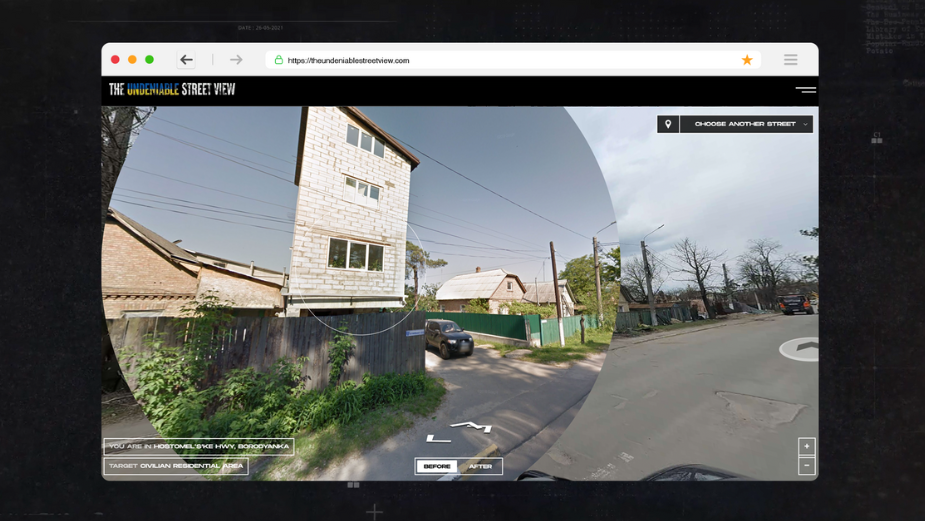
How ‘The Undeniable Street View’ Walked Us through Ukraine

Bringing in 5.5 million visitors from 154 countries, ‘The Undeniable Street View' website and campaign puts a spotlight on the war-torn streets of Ukraine. Over a year after Russia began its attack, there have been numerous casualties, adverse effects and widespread destruction - but not everyone can comprehend the atrocities.
Alongside president Volodymyr Zelenskyy’s UNITED24 organisation, the ‿ and us agency worked with Google Street View photographer Mykola Omelchenko to create the website which shows viewers from around the world the catastrophic results of war. By directly comparing the pre-war and post-war images through the use of Google Street View images and recently captured shots, the campaign aims are to raise awareness, see the truth of the situation and support organisations which are making a difference to Ukrainian citizens.
To understand how the campaign came together, ‿ and us’ executive creative director Jamie Kennaway sits down with LBB’s Nisna Mahtani.
LBB> It’s saddening that we have passed the one-year mark since Russia invaded Ukraine. When did you realise this milestone was approaching and that you needed to show the world the reality of what has happened?
Jamie> It is saddening indeed, and as we speak this is now heading well towards a second anniversary. The answer is we were looking to find any way to help for a while before the anniversary, but knowing this date was arriving gave us extra impetus to show the reality on the ground after 365 days of the full-scale invasion. In every war, there is the front line, and the information front line, which is being fought heavily by both sides.
The truth is a powerful weapon for Ukraine, and countering mistruth is a massive task. One of our key historical duties for us is to bear witness to the crimes being committed towards humanity, and it has a profound importance not just to document what happened but to hold perpetrators to account in the hope we can stop this from happening in the future.
The deliberate targeting of residential areas and civilian infrastructure in Ukraine by Russian forces had become a common theme of the war. We therefore needed to find a way for people from any country in the world who can’t visit Ukraine or see the destruction up close for themselves, to bear witness. We also wanted to do something that grabbed attention as a story, after so much news about Ukraine.
LBB> How was the process of collaborating with UNITED24, Voices of Children, Nova Ukraine and Vostok-SOS? What was each voice keen to highlight in this campaign?
Jamie> The process itself was initially tricky to make contact, present and bring everyone together on this. As you can imagine all these Ukrainian organisations are overwhelmed with daily vital work in their respective causes. However, the individuals and the organisations were amazing, everyone understood the value of putting their name to this and were fully supportive to endorse the project and be endorsed by the project.
Although we hoped some fundraising could come from this, we primarily made this project to create more witnesses to the crime of the full-scale invasion. With a small budget of $10,000, we also needed an idea powerful enough to get organic PR spread and media uptake – these organisations being part of the idea was part of this hook. We particularly worked heavily with UNITED24 (president Zelenskyy’s government fundraising initiative) who pushed the website across their social channels and were delighted by the results.
In terms of what each voice wanted to highlight – we made sure to individually push each organisation’s main purpose as a secondary tier of communication, but ultimately primarily this was about uniting together with ONE voice against the aggression and criminal targeting of civilian areas.
LBB> What is the main message of this campaign? What did you want viewers to come away with?
Jamie> The main takeaway here is two-fold. Firstly, to fight mistruth about the nature of the full-scale invasion where we would be held to believe the destruction is all part of a ‘special legitimate operation’ when in fact the reality is a criminal invasion – brutal and hitting much civilian infrastructure in the process (with many deaths).
The second message of this campaign is to continually support these Ukrainian humanitarian organisations and the overall Ukrainian cause. UNITED24 and the other organisations are on the ground helping people, rebuilding the nation, helping people in need, and defending their nation. They need support.
Ultimately there is also an underlying issue globally where people’s attention is wandering away from the conflict – the adage of “out of sight out of mind” has never been more apt. We, therefore, want to remind people that this is still happening one year on, with lives and communities being destroyed every day.

LBB> This campaign doesn’t just show the atrocities of war but is also going to be used as evidence of war crimes, sent to the Office of the Prosecutor General in Ukraine. Why was it important for it to have a strong purpose behind it?
Jamie> The purpose is clear for all to see. The moment we stop bearing witness, shining a light on or speaking up for what is right or wrong on issues that are fundamental to our humanity – is when we let the fabric of civilisation break down. This is just a tiny contribution, and though it may not change anything in itself, it keeps the energy flowing in the right direction.
LBB> How did Mykola Omelchenko come on board and how did you capture the street view images which feature?
Jamie> This was pure serendipity (like a lot of the project). It is the people involved and the energy they brought that got this project done. Once we had the idea, the first step was to work out if it was even possible to do – after all, taking street view footage of a current warzone has never been done before – because of the danger and also because of restrictions on Google to understandably not show anything that could hint at violence.
From a street view photography contact we already had, we were put in touch with Mykola, the official Google Street View photographer for Ukraine who in the war effort wanted to do this project. In his own words had been “fighting the war with his camera” for months – documenting the destruction the Russians had brought to his country with amazing work as part of a collective of Ukrainian photographers under the project name WAR UP CLOSE.
We initially were going to ask if it was possible to shoot some of the civilian areas and infrastructure targeted by the Russians, but once we spoke to Mykola, he told us that he had already had a whole batch of footage documented over 100km of six cities that had been on the front line – shooting with a 360 camera and Google Street camera on top of his car. So, he sent us everything and we looked through for the most powerful imagery, being careful to omit anything that was showing any scenes that were military-on-military – (our site was about showing the targeting of civilian areas).
We then designed each location to work from a user experience point of view so that when you selected a street, you were faced immediately with the shocking reality. We grew a friendship over this project with Mykola and are blessed to have met him as well. His VR project to inform as many people of the destruction can be seen here (war.city) and he is doing exhibitions across the USA right now to highlight this.
LBB> Why was it so important to showcase the before and after images of the country for people to see?
Jamie> This was important to give a point of reference and give context for the level of destruction pre-invasion vs post-invasion. By seeing what it looked like before, it hits home in a powerful way beyond just seeing the carnage (which in of itself is already powerful). There is something about reminding us what a better time used to look like and showing the senselessness of it all.

LBB> How did you decide on how the before and after images were presented?
Jamie> This was a workstream with our tech / UX team. We didn’t just want to make a feature where you flip between ‘before’ and ‘after’, but something more dynamic and engaging to use. We landed on a ‘lens’ tool which acts like a window to the past wherever you move it around the screen, while keeping the post-invasion scene as the base. This was simple to use but complicated to engineer as we needed to make sure the new destruction footage was placed in the perfect GPS coordinates as the original so the user experience would match up wherever you turned or walked and looked with your cursor – we needed this to feel seamless. In the streets where the GPS didn’t match perfectly, we couldn’t have this feature
LBB> What was the timescale of creating the campaign?
Jamie> We started in early January and released on February 24th on the one-year anniversary. It was a fast turnaround and a condensed amount of work from idea to execution and bringing everyone on board, but again with shared vision and energy from everyone involved, we got it done.
LBB> Talk to us about the copy which accompanies the campaign video. How did you strike the right tone and balance between what you said and how it supported the images displayed?
Jamie> The video needed to be as simple to follow as possible and emotionally powerful – we needed to remind viewers of the situation happening in Ukraine, the specific problem we are tackling (denials of targeting civilian areas), the idea and the execution. The tone needed to be serious, but defiant. We are showing the results of the invading forces’ attacks, but the website is a defiant act against these attacks and the perpetrators.

LBB> What was the most challenging part of working on this campaign?
Jamie> The most challenging part of the campaign was all of it. If one section didn’t work, this wouldn’t have happened. And this is why such a campaign should be extremely hard to do. Firstly, finding Mykola. Quite simply, this project could never have happened without him and his team and their bravery in capturing the footage as they did across six Ukrainian cities and regions.
Secondly, the exposure, legitimacy, and PR reach couldn’t have happened without UNITED24. Thirdly the sheer spread of the PR couldn’t have happened without the BBC approaching us having seen the project and wanting to make a short film about it for BBC world service. Fourthly, a dedicated creative team that worked around the clock helped to bring it to life. It is serendipity in many cases but definitely, a shared energy to bring this to life that made the near impossible, possible.
LBB> For people who want to help, what can they do to support Ukraine?
Jamie> It’s very simple:
1. Keep informed about what is happening there from different sources to inform others about the importance of keeping up support for Ukraine. Great pages to follow apart from western media are u24.gov.ua and united24.media on Instagram, and YouTube etc. – plus the Kyiv Post has great insight too.
2. Follow the other initiatives helping on the ground in Ukraine – Nova Ukraine, Voices of Children, and Vostok SOS.
3. You can support these institutions by donating. Each donation is vital in helping the humanitarian, rebuilding, and defence situation on the ground (you can pick where your money goes) – and there is a very high conversion rate where often 98-99% of your money goes to the end cause, rather than administrative costs.












